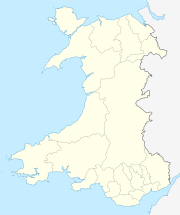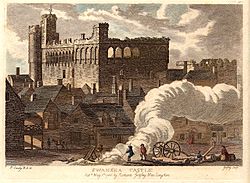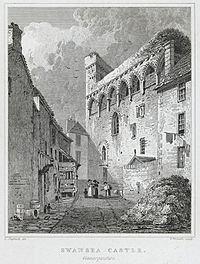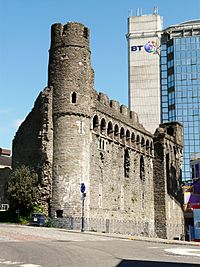Swansea Castle facts for kids
Quick facts for kids Swansea Castle |
|
|---|---|
| Swansea, Wales | |
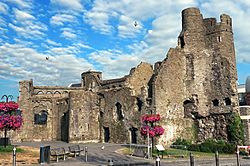
Swansea Castle today
|
|
| Coordinates | 51°37′13″N 3°56′28″W / 51.6203°N 3.9412°W |
| Type | Castle |
| Site information | |
| Condition | Ruins |
| Site history | |
| Built | 1107 |
| Battles/wars | 1116 – Partially destroyed by the Welsh 1192 – Survived a 10-week siege |
| Type: | Grade I listed |
| Designated: | 1952 |
Swansea Castle (in Welsh: Castell Abertawe) is an old castle in the middle of Swansea, Wales. A powerful man named Henry de Beaumont started building it in 1107. It was the main base (or caput) for the lordship of Gower, which was an important area back then. Today, the castle is mostly in ruins, with only two parts still standing. In recent years, the area around the castle has been made nicer for people to visit.
Contents
Where is Swansea Castle?
Swansea Castle is on the east side of the city centre. It faces a place called Castle Square. Long ago, the River Tawe flowed very close to the castle. The castle used to cover a large area, about 4.6 acres. What is left today includes parts of the living areas and a section of wall. There are also five basement rooms with arched ceilings.
History of the Castle
How the Castle Started
Henry de Beaumont was given control of the Gower area in 1106. He wanted to make sure the Normans had a strong hold there. Records show that a wooden castle was in Swansea by 1116. Welsh forces attacked it that year and destroyed its outer walls.
The first castle was likely a roughly oval shape. It looked over the River Tawe to the east. It had an inner area and a larger outer area. The inner part probably had a motte, which is a large mound of earth. This mound was about 52 meters wide, making it very big.
Attacks and Rebuilding
In 1192, a Welsh prince named Rhys ap Gruffydd attacked the castle. His forces surrounded it for 10 weeks. Even though the people inside were starving, the castle managed to survive.
The castle was attacked several more times. It fell in 1217 but was given back to the English in 1220. This happened as part of an agreement between Llywelyn ap Iorwerth and Henry III of England.
The castle was then rebuilt using stone. This work probably happened between 1221 and 1284. First, the inner castle was rebuilt with at least one tower. Later, the large outer area was also built.
The parts of the castle you can see today were built later. These are two sides of the rectangular southeast corner of the "new castle's" outer area. They were built in the late 1200s or early 1300s. The south wall has a tall tower for toilets (called a garderobe tower). It also has a beautiful row of arches at the top of the wall. These arches look like parts of other old buildings in Wales.
From Military Base to Other Uses
By the 1300s, Swansea Castle was not as important for fighting. Alina de Mowbray ruled the Gower area until 1331. Her son, John de Mowbray, then took over. He likely added the arched walkway to the castle walls.
During the Welsh rebellion led by Owain Glyndŵr in the early 1400s, many English castles were attacked. It is not known if Swansea Castle was captured. The castle's records only show that two men were sent to find out what Glyndŵr was doing.
Later, the castle owners often lived somewhere else. By 1650, the castle was described as "a decayed Buildinge" (a building falling apart). In the 1670s, a square tower was used as a bottle factory. In 1700, a town hall was built in the castle courtyard. By the mid-1700s, the Great Hall became a workhouse for the poor. The town hall was replaced by a post office in the 1800s. By 1850, a military drill room took the place of the workhouse. The River Tawe, which was once close to the castle, was moved and straightened in the 1840s.
Swansea Castle Today
In the early 1900s, parts of the castle's inside were removed. This included the large motte (earth mound). This was done to build a newspaper office between 1909 and 1913. The famous poet Dylan Thomas worked at this newspaper office in the early 1930s. The newspaper offices were taken down in 1976. After that, the castle remains were made stronger and opened for people to see from the street.
In 1952, Swansea Castle was given a special status. It became a Scheduled Ancient Monument and a Grade I heritage listing. This means it is a very important historical site.
For a long time, the castle was fenced off. It was only opened to the public on special days, like St David's Day in 2012. In the early 2010s, a new project began. Money from the European Regional Development Fund and Welsh Government helped to open the castle more often. A stone courtyard was built, and information panels were added. There were plans for stairs to reach the upper floors. The goal was to have public tours, events like markets, and for the castle to be part of a Swansea castle walking trail.
Images for kids


